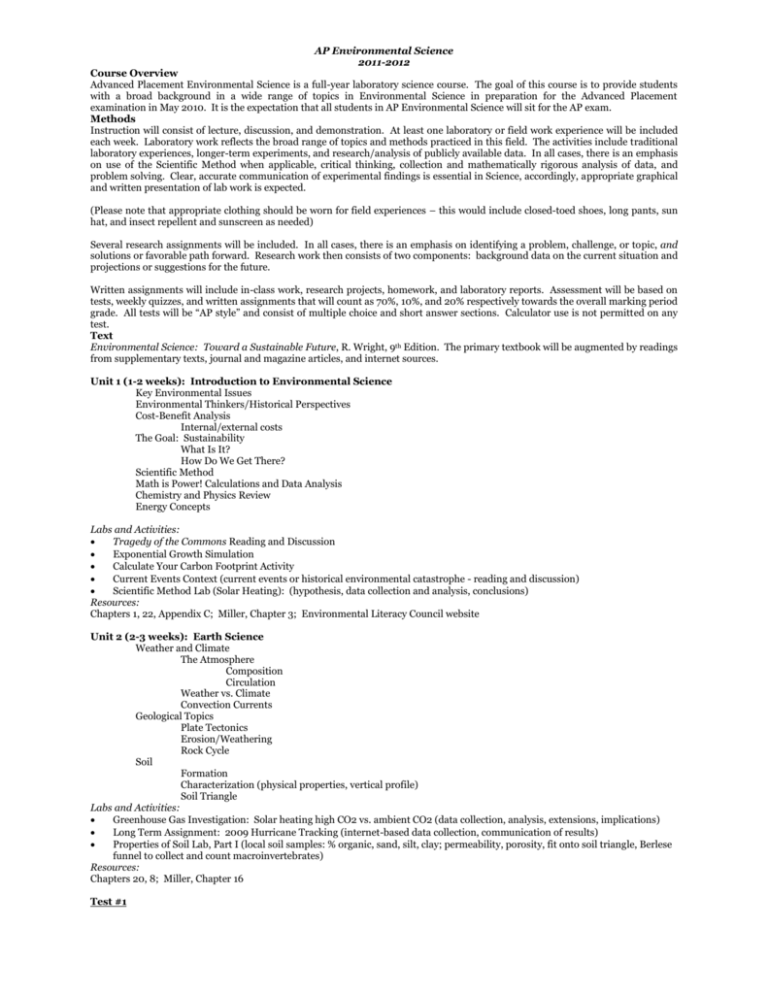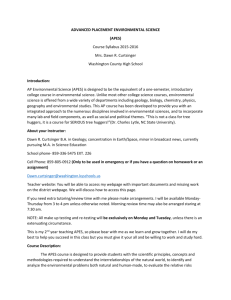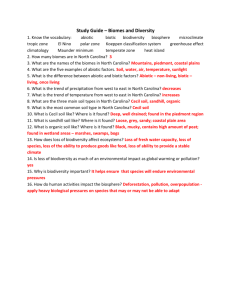AP Environmental Science
advertisement

AP Environmental Science 2011-2012 Course Overview Advanced Placement Environmental Science is a full-year laboratory science course. The goal of this course is to provide students with a broad background in a wide range of topics in Environmental Science in preparation for the Advanced Placement examination in May 2010. It is the expectation that all students in AP Environmental Science will sit for the AP exam. Methods Instruction will consist of lecture, discussion, and demonstration. At least one laboratory or field work experience will be included each week. Laboratory work reflects the broad range of topics and methods practiced in this field. The activities include traditional laboratory experiences, longer-term experiments, and research/analysis of publicly available data. In all cases, there is an emphasis on use of the Scientific Method when applicable, critical thinking, collection and mathematically rigorous analysis of data, and problem solving. Clear, accurate communication of experimental findings is essential in Science, accordingly, appropriate graphical and written presentation of lab work is expected. (Please note that appropriate clothing should be worn for field experiences – this would include closed-toed shoes, long pants, sun hat, and insect repellent and sunscreen as needed) Several research assignments will be included. In all cases, there is an emphasis on identifying a problem, challenge, or topic, and solutions or favorable path forward. Research work then consists of two components: background data on the current situation and projections or suggestions for the future. Written assignments will include in-class work, research projects, homework, and laboratory reports. Assessment will be based on tests, weekly quizzes, and written assignments that will count as 70%, 10%, and 20% respectively towards the overall marking period grade. All tests will be “AP style” and consist of multiple choice and short answer sections. Calculator use is not permitted on any test. Text Environmental Science: Toward a Sustainable Future, R. Wright, 9th Edition. The primary textbook will be augmented by readings from supplementary texts, journal and magazine articles, and internet sources. Unit 1 (1-2 weeks): Introduction to Environmental Science Key Environmental Issues Environmental Thinkers/Historical Perspectives Cost-Benefit Analysis Internal/external costs The Goal: Sustainability What Is It? How Do We Get There? Scientific Method Math is Power! Calculations and Data Analysis Chemistry and Physics Review Energy Concepts Labs and Activities: Tragedy of the Commons Reading and Discussion Exponential Growth Simulation Calculate Your Carbon Footprint Activity Current Events Context (current events or historical environmental catastrophe - reading and discussion) Scientific Method Lab (Solar Heating): (hypothesis, data collection and analysis, conclusions) Resources: Chapters 1, 22, Appendix C; Miller, Chapter 3; Environmental Literacy Council website Unit 2 (2-3 weeks): Earth Science Weather and Climate The Atmosphere Composition Circulation Weather vs. Climate Convection Currents Geological Topics Plate Tectonics Erosion/Weathering Rock Cycle Soil Formation Characterization (physical properties, vertical profile) Soil Triangle Labs and Activities: Greenhouse Gas Investigation: Solar heating high CO2 vs. ambient CO2 (data collection, analysis, extensions, implications) Long Term Assignment: 2009 Hurricane Tracking (internet-based data collection, communication of results) Properties of Soil Lab, Part I (local soil samples: % organic, sand, silt, clay; permeability, porosity, fit onto soil triangle, Berlese funnel to collect and count macroinvertebrates) Resources: Chapters 20, 8; Miller, Chapter 16 Test #1 Unit 3 (5-6 weeks): Living Systems Ecosystems Structure Major Terrestrial and Aquatic Biomes Climatology Energy Flows in Ecosystems Trophic Categories Food Webs Respiration, Photosynthesis, Fermentation Energy Flow Pyramid Matter Flows in Ecosystems Biogeochemical Cycles Ecosystem Diversity Ecosystem Change Climate Shifts Ecological Succession Population Concepts Carrying Capacity Reproductive Strategies Survivorship Curves Keystone Species Predator-Prey Relationships Competition Natural Selection and Adaptation Labs and Activities: Climatogram Construction Activity Aquatic Primary Productivity Lab (changes in stream water DO with and without light) Terrestrial Primary Productivity Lab (Measure NPP of rye grass by weight increase) Biodiversity Measurement Fieldwork ((1) quadrat sampling and analysis (2) sampling field insects and soil invertebrates graphing and analysis (Shannon-Weiner Diversity Index) Predator-Prey Simulation (plotting model data and drawing conclusions, test perturbations) Long Term Research Project Start: Introduced Species. (identify one non-native species, research where, when, why, mitigation if any, projections for future. Written report and presentation) Resources: Chapters 2, 3, 4 Test #2, 3 Unit 4 (2-3 weeks): Human Population Human Population Dynamics Population Growth and Doubling Time Population and Social and Economic Conditions Demographic Transition Population Pyramids Population Distribution Impacts of Growing Human Population Human Health, Economic, Environmental Impacts IPAT Model Towards Sustainability Population Size Case Studies Social and Political Context Labs and Activities: Survivorship Lab (gather cemetery data or on-line) Exponential Population Growth Activity (re-visit activity from first weeks expand analysis and discussion) Global Population Investigation: Constructing and Comparing Population Pyramids (construct age-sex profiles from available data, graphically analyze relationship between profile shape and demographic and economic factors) Debate: Critical Evaluation of Sustainability Case Studies Resources: Chapters 5, 6 Test #4 Unit 5 (3-4 weeks): Water and Land Use Water Topics Global Water Resources Hydrologic cycle Groundwater Human Impacts Dams, Levees, Wells, etc. Use, Conservation, Recycle Soil/Land Topics Soil Nutrients and Plant Growth Soil Degradation and Conservation Case Studies: The Dust Bowl, The Sahel Food Production Subsistence Farming and Modern Industrial Agriculture Genetically Modified Organisms and GM Foods Food Security, Economic and Social Factors Labs and Activities: Local Water Use/Water Use Audit Activity Water Quality Index Lab (use local water samples: as possible, determine DO, pH, change in temperature, fecal coliform, BOD, nitrates, total phosphorous, total dissolved solids, turbidity) Soil Salinization Lab (experimental design, graphical data analysis and conclusions) Debate: Hardin’s “lifeboat ethic” Long Term Project Start: Survey of US and World Environmental Laws (given topics-research existing and pending, tabulate, evaluate, and communicate results) Resources: Chapters 7, 8, 9 Test #5 Unit 6 (2-3 weeks): Biodiversity and Wilderness Value of Biodiversity/Global Distribution of Biodiversity Decline of Biodiversity Causes Consequences Legislation and Social Issues Endangered Species Act Land Types and Use Agriculture Forestry: old growth, plantations Rangelands: effects of grazing Mining Rock and Mineral Uses Exploration and Mining Techniques Environmental Impacts Other Uses Urban Development Transportation Issues Wilderness, Conservation and Preservation History Public and Private Lands National Parks Service, National Forest Service, National Wildlife Refuges Marine Resources Fishing Aquaculture Relevant Laws and Treaties MovingTowards Sustainability Labs and Activities: Revisit Biodiversity Data from fall (collect additional, extend, data set as possible) Fish Banks Simulation Activity (game, modify and extend with new “technology”) Forestry Activities (sampling and analysis) Resources: Chapters 10, 11 Test # 6 Unit 7 (4-5 weeks): Energy – Resources and Consumption Energy Concepts Consumption: History and Forecasts Non-Renewable and Renewable Energy Sources Fossil Fuels: Coal, Oil, Natural Gas Formation Discovery, Extraction, Purification Uses Nuclear Power Fission - Today Fusion – Tomorrow? Hydroelectric, Geothermal Solar, Wind, Biomass Emerging Energy Sources Environmental Impact and Feasibility of Energy Sources Critical Analysis of Advantages and Disadvantages of Fossil Fuels and Alternative Energy Sources Social and Political Issues Conservation Local, National, Global Energy Efficiency: Two Areas: Electricity, Transportation Legislation: CAFE Labs and Activities: Personal Energy Use Audit Electric Meter Activity (can you get your home meter to slow? To stop? Why?) Debate: Hubbert Curve Solar Absorption Lab (solar oven experment with awards for meeting specific design goals) Radioactive Decay Lab (radioactive waste half life simulation using M&Ms, plotting, analysis) Short Term Research Project: Evaluate an Emerging Power Source (poster&presentation) Survey Project: NIMBY survey of student attitudes Resources: Chapters 12, 13, 14; Department of Energy website Test #7 Unit 8 (4-5 weeks): Pollution Pollution Types Air: Types, Sources, Effects, Mitigation, Regulations Water: Types, Sources, Effects, Mitigation, Regulations Solid Waste: Types, Sources, Effects, Mitigation, Regulations Other: Thermal, Noise Pests and Pest Control Defining Pest and the Need for Pest Control Chemical and Alternative Approaches Bioaccumulation and Biomagnification Impact on Environment and Human Health Toxicology Fundamentals Agents and Efffects Chronic and Acute Exposure Dose-Response Relationship LD-50 Risk Assessment Economics of Pollution Cost-Benefit Analysis Revisted Internal/External Costs of Pollution Labs and Activities: Cap-and-Trade Game Activity (model CO2 emission control scheme) Acid Rain Lab (pH measurements of collected rainwater/snow and analysis) Particulate Matter Investigation (collect data on PM, analyze, compare to available data) Solid Waste Activity (student household based – quantify one week of household waste, collect data, organize data in effective/persuasive manner, propose ways to reduce) LD-50 Lab (LD-50 determination using household chemicals and brine shrimp) Debate: Students research Cost-Benefit scenarios and debate Resources: Chapters 15-19, 21 Test #8 Unit 9 (3-4 weeks): Global Change Atmospheric Composition, Energy, Circulation Stratospheric Ozone Formation Chemistry, Destruction Forecast Global Climate Change Natural Climate Change – Ice Ages Greenhouse Gases Chemistry and Action Historical Record to Present Day and Projections Impact of Projected Global Warming (Environmental, Social, Economic) Mitigation Loss of Biodiversity Continued From Unit 6 Labs and Activities : Global Warming Evidence (analysis of primary data, review, conclusions, and debate) Greenhouse Gas Lab (revisit introductory activity as a demo, with discussion) Project: Global Warming Implications for NJ (students identify, research, quantify and communicate implications of one likely result of global warming on our state) Calculate Your Carbon Footprint Again (lessons learned - and applied?) Prepare and Plant 3 Sisters for Next Year (summer help needed) Resources: Chapter 20; Intergovernmental Panel on Climate Change Summary, 2007. Unit 10 (remaining time until exam): Review for AP Examination






